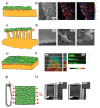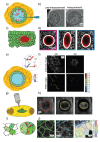Measuring mechanical stress in living tissues
- PMID: 39867749
- PMCID: PMC7617344
- DOI: 10.1038/s42254-020-0184-6
Measuring mechanical stress in living tissues
Abstract
Living tissues are active multifunctional materials capable of generating, sensing, withstanding and responding to mechanical stress. These capabilities enable tissues to adopt complex shapes during development, to sustain those shapes during homeostasis, and to restore them during healing and regeneration. Abnormal stress is associated with a broad range of pathologies, including developmental defects, inflammatory diseases, tumor growth and metastasis. Here we review techniques that measure mechanical stress in living tissues with cellular and subcellular resolution. We begin with 2D techniques to map stress in cultured cell monolayers, which provide the highest resolution and accessibility. These techniques include 2D traction microscopy, micro-pillar arrays, monolayer stress microscopy, and monolayer stretching between flexible cantilevers. We next focus on 3D traction microscopy and the micro-bulge test, which enable mapping forces in tissues cultured in 3D. Finally, we review techniques to measure stress in vivo, including servo-null methods for measuring luminal pressure, deformable inclusions, FRET sensors, laser ablation and computational methods for force inference. Whereas these techniques remain far from becoming everyday tools in biomedical laboratories, their rapid development is fostering key advances in the way we understand the role of mechanics in morphogenesis, homeostasis and disease.
Figures







References
-
- Guillot C, Lecuit T. Mechanics of epithelial tissue homeostasis and morphogenesis. Science. 2013;340:1185–1189. - PubMed
-
- Barker N. Adult intestinal stem cells: critical drivers of epithelial homeostasis and regeneration. Nature Reviews Molecular Cell Biology. 2014;15:19–33. - PubMed
-
- Krndija D, et al. Active cell migration is critical for steady-state epithelial turnover in the gut. Science. 2019;365:705–710. - PubMed
-
- Northey JJ, Przybyla L, Weaver VM. Tissue Force Programs Cell Fate and Tumor Aggression. Cancer Discovery. 2017;7:1224–1237. doi: 10.1158/2159-8290.CD-16-0733. - DOI - PMC - PubMed
LinkOut - more resources
Full Text Sources
